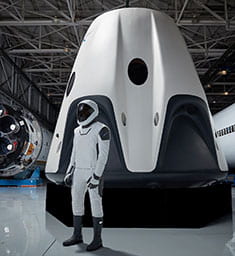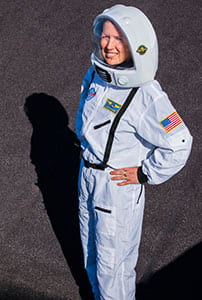The New Race For Space
On 20 July 2019 it will be 50 years since man walked on the Moon, but what will the next 50 years hold? Professor Lucy Berthoud tells us what could be instore from space tourism to life on Mars.
It’s 50 years since US astronaut Neil Armstrong took his first ‘small step’ on the moon, and as he poignantly stated at the time, the Apollo 11 Moon landing was unquestionably a giant leap for mankind. Half a century on as a spacefaring species, government-funded programs have seen us inhabit a space station, master low-Earth orbit and make incredible strides in the development of satellite technology. But, in terms of the advancement of space exploration, what will the next 50 years bring us? What will be happening in the skies above us in 2069?
Space holiday
Bristol University’s Professor Lucy Berthoud, a lecturer within the Faculty of Engineering who teaches the space aspects of the Aerospace Engineering degree, believes it could be a great deal.
“Hopefully, in a few years, people will be travelling in low earth orbit just as frequently as they travel now on commercial aircraft.”

“In the short term, we will see the establishment of space tourism in low earth orbit and if they can manage the safety aspects, hopefully, in a few year’s time, people will be travelling in low earth orbit just as frequently as they travel now on commercial aircraft.” Space tourism is space travel for recreational purposes – and the possibilities, including orbital, suborbital and lunar, are seemingly endless. It is no wonder, then, that it is an area of great interest to a new breed of space entrepreneur, with dot.com billionaires such as Elon Musk and Jeff Bezos investing heavily.
Another field where the technology is currently evolving before our eyes is in the development of reusable rockets. Indeed, space companies are ploughing millions into this area with the promise of huge rewards. The prospect of sending rockets into space and then bringing them back to Earth is a tantalising one. As Professor Berthoud attests: “Being able to recover rockets is a necessity in terms of making space tourism financially viable.” At the moment, sending a rocket to the International Space Station costs in the region of £48 million and each rocket can only be used once. Bezos, founder of spaceflight company Blue Origin, famously compared this to using a Boeing 747 to fly across the country once and then throwing the plane away. He has a point.
Galactic gas stations
You would think that predicting long-term developments in space technology is a much more difficult prospect, but this doesn’t faze Professor Berthoud one bit. “There’s a path you have to follow for space exploration. It’s an obvious progression, we’re nothing if not logical in my industry!”

The first mid to long-term development she expects to see is an inhabited base on the Moon. “There is debate as to whether it should be the Moon or Mars,” she states. “But it seems to me that the Moon would be a strong progression. It’s much closer, comparatively simpler to resupply and if things did go wrong, it’s easier to get people back. Mars is a much higher risk.” Professor Berthoud’s comments link closely to the Deep Space Gateway, a proposed NASA programme that would bring astronauts to the moon to operate a cis-lunar space station. The concept has generated a wealth of research since 2017, especially because NASA’s stated goal, under the current Trump administration, is to return to the moon before going to Mars.
According to Professor Berthoud, other possibilities include the mining of the asteroids (“That has to be done”), the establishment of fuel depots in space – the so-called ‘galactic gas stations’ – as well as the research and exploration of exoplanets, the bodies beyond our own solar system.
“In terms of the next 50 years, discovering life remains the biggest milestone of them all.”
Primarily, she believes that looking for life on other planets remains the ultimate goal. “It’s clearly challenging and deeply difficult to establish whether there is life. For instance, recent research indicates that there is an underwater lake under the ice near the south pole of Mars, which could be a suitable place for life to develop. Mars is fascinating. In terms of the next 50 years, discovering life remains the biggest milestone of them all.”
Space, Inc.
The sustained activity and increasing investment in the fantastic potential of space from both government agencies and Silicon Valley billionaires such as Musk and Bezos is welcome. The growth in the ‘everyday’ applications of space means that a lot more people can now readily see the benefits of space.
Want to study Aerospace Engineering?
“I’ve seen a real surge of interest from students,” says Professor Berthoud. “Whereas previously somewhere in the region of 10 per cent of the aerospace engineering students would be interested in space, in the last few years, it has really jumped. These days, in the region of half the class would like to work on space projects if they can.”
“The space industry is no longer deemed to be a space-agency-dominated world, but rather an exciting commercial industry.”
But why the surge of interest? “Students are regarding space much more like an industry. Even some of my entrepreneurial students who wouldn’t have typically particularly leaned towards space are now doing so because it is no longer deemed to be a space-agency-dominated world, but rather an exciting commercial industry.”
Indeed, these are exciting times at the University of Bristol in terms of space research, with the opening of a new state-of-the-art satellite laboratory and ground station. As Professor Berthoud explains: “The lab enables students to work on University of Bristol space missions with the design and testing of our own satellites. The ground station can track satellites in orbit, and, in theory, we will be able to talk to the astronauts on the International Space Station.”
Lucy in the sky

This shift in perception of space as a commercial opportunity as opposed to the impossible stuff of dreams is something Professor Berthoud has observed closely over her career in the space industry. But what was the initial inspiration behind her fascination with space?
“When I was a kid, I really loved science fiction and so I decided I wanted to be an astronaut at the age of 11! The idea of working in space and on another planet seemed to be too good to be true. I was also fascinated by how things work and so that led me to choose engineering as a career. I really like the exploration part of space, because it appealed to the adventurous side of me.”
Now, as an inspiration to her own engineering students, Lucy hopes they will help develop the technologies, vehicles and infrastructure needed to power the next 50 years of space exploration.
Academic profile
Name: Dr Lucy Berthoud MEng (Bristol) PhD (Toulouse)
Title: Professor of Space Engineering
Courses: MEng Aerospace Engineering
Background: Professor Berthoud has worked for 25 years in Spacecraft research and in industry. She started out with a Master’s in Mechanical Engineering from the University of Bristol, then went to Toulouse where she studied for a PhD in Space Physics at Sup’Aero/ONERA (French National Research Organisation). She then did post-doctoral fellowships at the European Space Agency and NASA Johnson Space Centre. In 2009, Dr Berthoud started teaching at the University of Bristol and is now a Professor of Space Systems Engineering in the Aerospace Engineering department.


